I Explored Rwanda's Hidden Gems With My Family — Here's Why You Should, Too
An inside look at the culture of Rwanda, why gorilla trekking will take your breath away, and how to plan your trip.
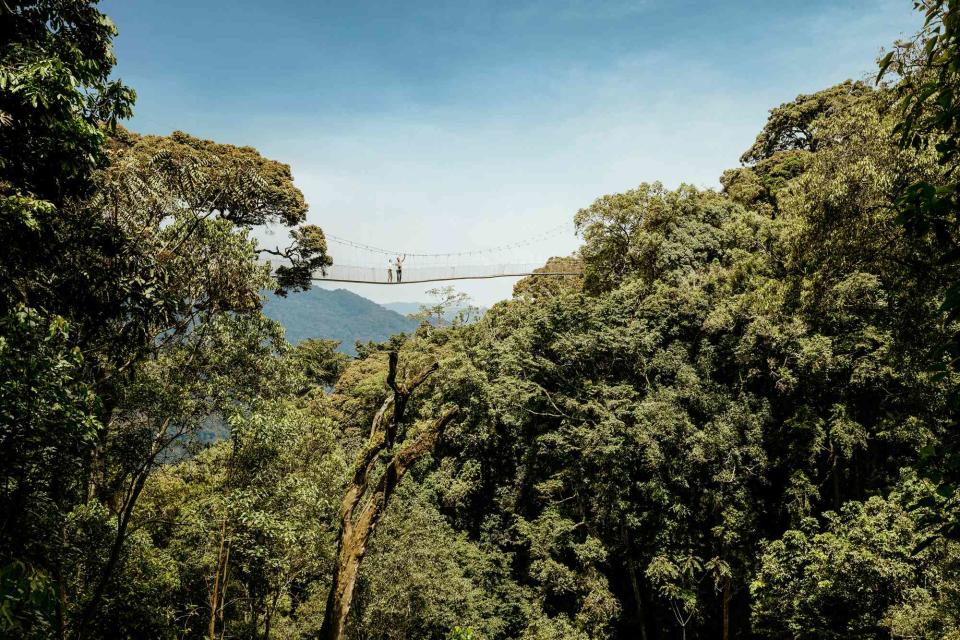
Courtesy of One&Only
The battle-worn hippo trotted into the acacia trees, surprisingly light on its feet. Not exactly one of the dancers from Fantasia, but even with layers of scar tissue covering its side, the creature embodied grace and resilience in the bush.
Less than 24 hours into our stay at Rwanda’s Akagera National Park — a swath of savanna, swamps, and lakes some 100 miles east of the capital, Kigali — my family and I had already become accustomed to the hippos. Scores of them dotted the surface of Lake Rwanyakazinga, home to Wilderness Magashi, an eight-suite, solar-powered tented camp on the shore. At night, though I was snug with hot-water bottles in our king-size bed, their harrumphs kept me awake — an insomniac’s dream.
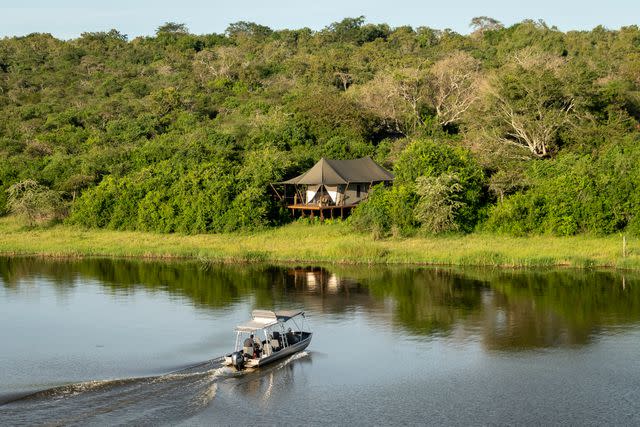
Courtesy of Wilderness Safaris
A guest tent along the water at Magashi Camp.But seeing this solitary hippo on the move, on land, gave us all a sense of the animals’ true size and speed. “When hippos fight, they use their teeth like spears,” explained our soft-spoken Rwandan guide, Herman Nkusi, who, on a later game drive, found two incisors lying in a small grove. My son, Bobby, lifted one up and down like a barbell, the tooth nearly as long as his arm.
After the 1994 genocide — in which an estimated 800,000 Rwandans were murdered over a 100-day period — Akagera’s size was greatly reduced, as land was reallocated. Poaching was left unchecked, meaning much of its native wildlife was also lost. In 2010, the Rwanda Development Board and African Parks, a conservation nonprofit, joined forces to rehabilitate the reserve, which now covers 433 square miles. In 2015, lions were reintroduced, followed by rhinos in 2017. It is now possible to see the Big Five in Akagera, putting it in select company with such destinations as Kruger National Park in South Africa and the Ngorongoro Conservation Area in Tanzania. One evening at sundown, we happened upon a female rhino and her six-month-old calf, their precious horns bobbing up and down as they grazed for dinner. No other vehicles were around us.
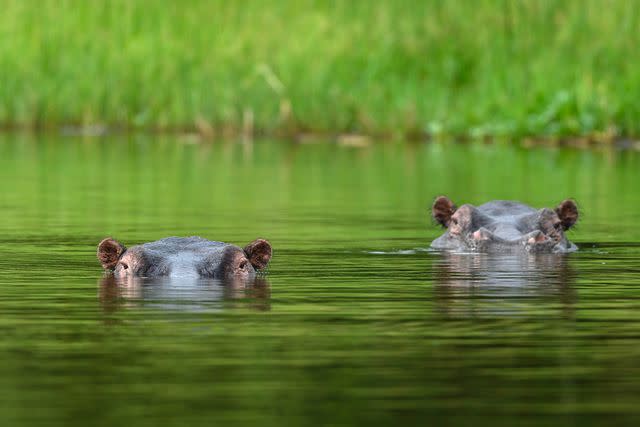
Courtesy of Wilderness Safaris
Hippos peeking out of the water near Magashi Camp in Rwanda.The evolution of Akagera, like tourism in Rwanda overall, has been slow, deliberate, and remarkable, given the circumstances. Wilderness Magashi opened in May 2019; Magashi Peninsula, a four-suite companion property, is in development. Though we saw no other children during our stay, the camp felt very accommodating to families, with a small dipping pool and a nurturing staff. Nkusi, whose wife was expecting their first child, offered up his copilot seat and walkie-talkie to Bobby each afternoon — the quickest way to an eight-year-old boy’s heart.
Multigenerational travel, which has exploded post-COVID in tried-and-true safari destinations like Kenya and South Africa, is still nascent in Rwanda, in part because the minimum age for gorilla trekking in Volcanoes National Park is 15. But we discovered that going a little deeper, beyond the destination's most famous activity, leads to some remarkable experiences, for all ages.
“We’ve raised three biological and three adopted children here, and found so many family-friendly activities beyond the gorillas,” said Alissa Ruxin, who, along with her husband, Josh, owns the Retreat by Heaven, a 20-room luxury hotel in Kigali’s central Kiyovu district. It is a divine, welcoming place to recharge after a long flight: Bobby gravitated to the shaded pool and the chessboard with gorilla pieces in the open-air reception area — an invitation to play, if ever there was one.
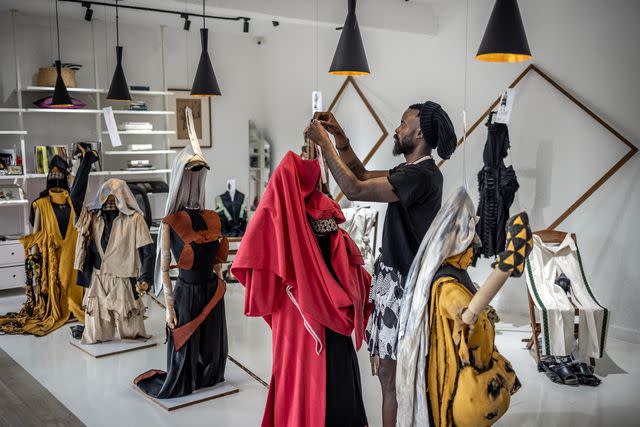
Luis Tato/AFP/Getty Images
Designer Moïse Turahirwa styling pieces in their studio in KigaliRuxin suggested biking in the new Nyandungu Urban Wetland Eco-Tourism Park or ziplining at the Fazenda Sengha recreation center on Mount Kigali as day excursions. But our adventures took a more sartorial turn. Bobby, who loves dressing up, had a beaded bracelet custom-sized at Moshions, a gender-neutral Kigali boutique run by the energetic, supremely stylish Moses Turahirwa, who ran upstairs to their workshop to get the fit just so. Moshions is one of several emerging brands — others include K’tsobe, a brass jewelry brand by Sarah Legrand, and Asantii, a contemporary women’s line founded by Maryse Mbonyumutwa — with stores and ateliers open to visitors, making fashion here accessible and welcoming.
Through her larger enterprise, Pink Mango, Mbonyumutwa employs around 1,000 people (80 percent of them are women) to produce clothing for not only Asantii but also other global brands, white-label. One morning, she led us around two of her airplane-hangar-esque factories in Kigali’s “Special Economic Zone,” an industrial area 30 minutes from the city center. “We’ve got a training section for embroidery here, and then we also work with cooperatives of women in rural areas,” she said as a nearby employee finished work on a white Asantii blouse.
At one factory, we toured a daycare and kindergarten run by Pink Ubuntu — Pink Mango’s social-impact arm — which opened in 2021 to support the children of female employees. Bobby told Mbonyumutwa about the similarities to his former school back home (the cots for nap time, ABCs written on the wall). As we left, I noticed block letters running above the cubbyholes. They spelled out "Amazing Things Happen When You Try."

Courtesy of The Legacy Untold
“Are we sure this is a good idea?”
My husband, Rob, was wondering why Bobby was leading the charge at the Canopy Walkway: a gently swaying suspension bridge 230 feet up in the treetops of Nyungwe National Park. Kids as young as six are permitted to cross the 525-foot-long structure, one of the park’s marquee attractions, along with some 310 bird species, hiking trails, waterfalls, and chimpanzee treks. In September 2023, Nyungwe, which spans 252,000 acres of forest in Rwanda’s southwestern corner, was named a UNESCO World Heritage site — the country’s first.
After descending 45 minutes down the Igishigishigi trail — the path all travelers must follow, accompanied, to the walkway and back — Bobby was determined to be the first one to cross the bridge. And truth be told, I didn’t want to go first. “Baby steps!” I shouted to him as we all made the crossing, sending up a prayer that an afternoon shower wouldn’t appear, as sometimes happens in November, which is rainy season.
Rivulets of sweat poured off my palms. “We did it! ” I exclaimed as I grabbed Rob and Bobby’s hands on the other side. Unlike mine, theirs were as cool as cucumbers.
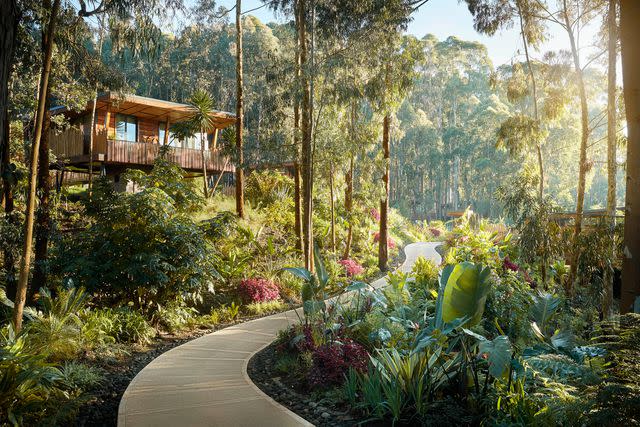
Courtesy of One&Only
A guest room along the grounds of One&Only Gorilla's NestComing off that adrenaline rush, we collapsed in our plush, earth-toned suite at the 22-room One&Only Nyungwe House, a cluster of wooden villas and a main house with soaring ceilings and a grand fireplace, in the middle of a heart-stoppingly beautiful tea plantation. Our time there was short, but sweet: Rob and I rose at 4:30 a.m. to go on a five-hour chimp-trekking excursion (grueling, definitely not for the kids) while Bobby took a cooking and painting class in the lobby, with the fields outside for inspiration. Later on, we all gathered with women from the Nyungwe Cultural Village cooperative, who harvest tea for a living. They taught us how to sort the thick, healthy green leaves into giant baskets strapped onto our backs. When nature is at your fingertips, a kids’ club is superfluous.
“You have to mimic the sound that you are hearing,” explained Kadiara King’ai, manager of guest services at the Dian Fossey Gorilla Fund. We were touring the fund’s state-of-the-art Ellen DeGeneres Campus, inaugurated in 2022 on the outskirts of Volcanoes National Park, a 62-square-mile patch of rain forest in Rwanda’s northwest. Designed using local volcanic stone, the contemporary campus is part research and education center, part interactive museum — and a brilliant place for children to engage with conservation.
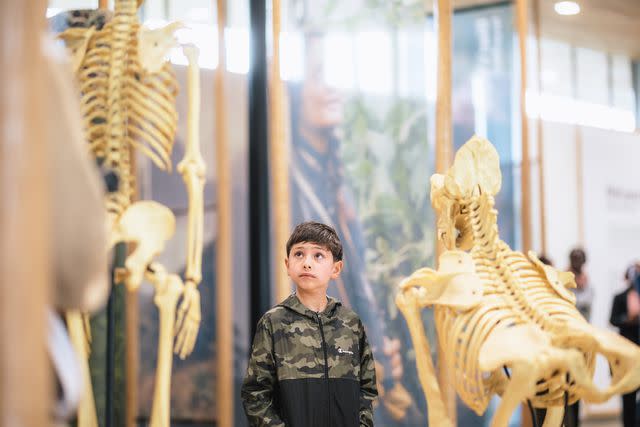
Courtesy of The Legacy Untold
Bobby taking in the skeleton display at the Dian Fossy Ellen Degeneres CampBobby was at the “gorilla chat” display, where you can learn how the animals communicate. After listening to recordings of them laughing, crying, singing, and beating their chests, we each took our turn, breaking down our inhibitions by trying to copy them. We wandered into a recreation of Dian Fossey’s cabin, which displays some of the legendary primatologist’s personal effects, as well as a model of a mountain gorilla skeleton next to a human one. King’ai even took us to a separate lab, where research is still being done on the thousand or so mountain gorillas left in their wild, to show us brown paper bags filled with their frozen poop, which reveal many tidbits of biological information — including whether or not the animals are stressed.
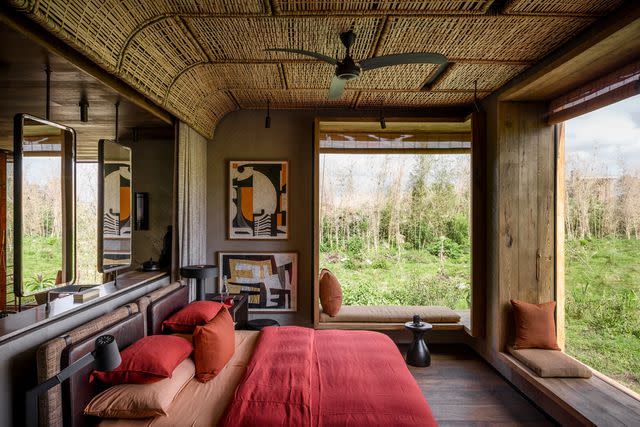
Courtesy of Singita
A suite at Singita Kwitonda campAfter hours of learning about them at the campus, telling Bobby that he wouldn’t be able to see the gorillas up close was not an easy conversation. The displays profiling Digit, one of Dian Fossey’s favorites, had made quite an impression. But I gently explained that there would be plenty of other things for him to do at each of our hotels — archery and a drumming lesson at One&Only Gorilla’s Nest, which also happens to have a spectacular infinity pool — as well as games, coloring, and endless croissants at Singita Kwitonda Lodge, both of which are within 15 minutes or so of the park. It was time for Dad and me to be alone, for a bit.
Gorilla trekking can be an all-day affair; visitors are each assigned a family group on the morning of the trek, and go where they go. I wasn’t prepared for some of the hiking hazards: the mud, the fire ants, the stinging nettles. But once we reached the Hirwa group — a family of 17 with a rare set of rambunctious male twins — my adrenaline kicked in. Due to park rules, we had only an hour in their presence. It was go time.
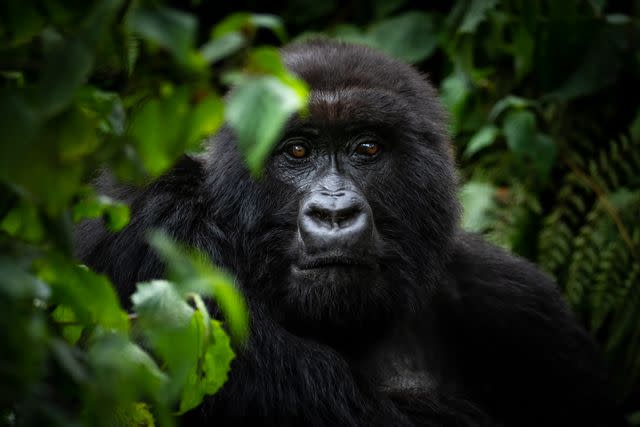
Ross Couper/Courtesy of Singita
A gorilla in the Sabinyo family at Volcanoes National Park in RwandaOne of the twins reached into the ground, then pulled out a handful of ants and licked his fingers clean. Two juveniles spun in circles around a bamboo tree as the silverback came over to supervise. I noticed one smaller, slower gorilla taking cover from the rain in the underbrush, its rheumy eyes displaying a world-weariness that the younger, more nimble animals didn’t seem to have. Turns out, she was Kibyeyi: at 49, one of the oldest female gorillas in the park. I made sure to tell Bobby all about her when I got back.
How to Book a Trip to Rwanda
Mark Lakin, founder and CEO of the Legacy Untold, is a safari specialist and member of T+L’s Travel Advisory Board. Lakin and his team can plan a multi-stop itinerary, arrange car and helicopter transfers, meals, meet-and-greets with designers, and trekking excursions.
For more Travel & Leisure news, make sure to sign up for our newsletter!
Read the original article on Travel & Leisure.


